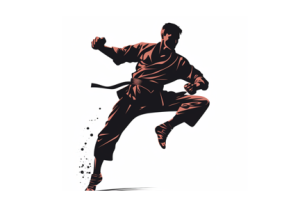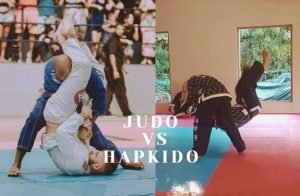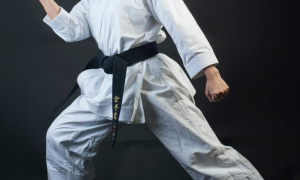
Karate, a martial art of discipline and strength, hinges on the mastery of punches that pack a punch. Hold tight as we delve into the essence of these punches, uncovering the basic, advanced and best Karate punches.
Table of Contents
Toggle![]()
The Significance of Karate Punches
A karate punch is more than just a strike – it is an elegant blend of technique, precision, and power. At the heart of every punch is proper form, which synchronizes movement to generate maximum impact.
The stance grounds the body, with feet shoulder-width apart and weight centered. Hips rotate to add torque while shoulders stay relaxed. The punching arm extends fully, aligning wrists and knuckles. This orchestration of body mechanics is the foundation for delivering potent strikes.
The twist of the hips and pivot of the feet combine to create a devastating whip-like action. The power originates from the hips and flows upwards through the torso, before being transmitted through the shoulder and down the arm into the fist. Proper technique maximizes kinetic linking for optimum force delivery.
But power alone is not enough. The punch must strike with surgical accuracy. This precision transforms raw power into a work of martial arts mastery. Only perfect technique allows a fighter to exploit tiny openings in the opponent’s defense.
Master karateka blend proper form, hip power, and precise delivery to turn their fists into paintbrushes on the canvas of combat. The punches become brushstrokes of artistic expression. For in the hands of the master, karate punching is truly an art form.
Now, let’s zoom in on the three musketeers of effective punching: form, power, and precision. These elements, like interlocking gears, are the essence of a karate punch that resonates.
| Element | Description |
|---|---|
| Form | Imagine a sculptor carving a masterpiece. Your body is the raw material; form shapes it. |
| Power | Picture a surging wave, building in intensity. Your core, hips, and legs provide that surge. |
| Precision | Imagine a laser-guided missile hitting its mark. Precision turns raw power into art. |
Form empowers the punch, precision aims it, and power propels it like a rocket.
![]()
The Best Karate Punches
In karate, punches are judged not by brute force, but by a combination of effective technique and artistic expression. The “best” punches maximize impact while exemplifying impeccable form. Here are some of the most prized punches in a karateka’s arsenal:
| Karate Punch | Description |
|---|---|
| Reverse Punch (Gyaku Zuki) | Executed with the rear hand while rotating the hips and torso for power. A foundational karate strike. |
| Jab (Kizami Zuki) | A quick, snapping punch with the lead hand. Fast and precise. |
| Vertical Punch (Ura Zuki) | A close-range body punch utilizing a vertical fist for maximum penetration. Devastating at close quarters. |
| Roundhouse Punch (Mawashi Zuki) | Whips horizontally from the outside, adding swing to impact. |
| Hook Punch (Kage Zuki) | Strikes diagonally, often around an opponent’s guard. |
The aesthetics of a picture-perfect punch may appear effortless. But mastery demands lifelong dedication to technique and form. Power must be applied intelligently, like a scalpel rather than a club. Only through zanshin – the fusion of physicality with presence of mind – can one truly master impactful punches as artistic expressions.
![]()
Basic Karate Punches
Mastering key punches is akin to mastering the notes in a melody – each punch contributes to the symphony of combat. These key punches are the foundation of a martial artist’s repertoire, forming the building blocks for more advanced techniques. In karate, mastering these foundational punches is crucial before delving into the intricacies of advanced techniques.
These basic punches serve as the cornerstone of effective karate techniques:
| Punch Type | Description |
|---|---|
| Middle Punch | Imagine a bullet – straight, direct, and effective. The middle punch is the essence of karate. |
| Straight Punch | Like an arrow finding its mark, the straight punch is swift and precise. |
| Hook Punch | Curving like a river, the hook punch adds versatility to your arsenal. |
| Jab | Quick and snappy, the jab sets the rhythm and creates openings for more powerful strikes. |
| Cross | The cross punch is a heavyweight champion, delivering immense power from the back hand. |
Advanced Karate Punches
Foundational punches lay the groundwork, but advanced punches elevate your game. It’s like progressing from a basic brushstroke to a captivating painting. While foundational punches are about directness, advanced punches introduce complexity. Imagine you’re driving – the road is clear, but suddenly, you encounter twists and turns. Advanced punches add these twists, catching opponents off guard.
Advanced punches bring a layer of sophistication and surprise to your karate arsenal:
| Punch Type | Description |
|---|---|
| Double Punch | Picture a one-two punch, lightning-fast. The double punch keeps opponents on their toes. |
| Uppercut Punch | Like a rising phoenix, the uppercut targets the chin, a potent surprise in close combat. |
| Backfist Punch | Swift and unexpected, the backfist can disrupt your opponent’s rhythm in an instant. |
| Spinning Backfist | Adding a spin to the backfist, this punch generates centrifugal force for extra impact. |
| Knifehand Strike | Mimicking a knife, the edge of the hand becomes a weapon, delivering a focused blow. |
| Hammerfist | A vertical fist like a hammer – this punch is effective for downward strikes. |
The Double Punch in Karate
The karate double punch is all about speed, power and control. As the name suggests, it involves throwing two quick punches in rapid succession, overwhelming your opponent. Mastering this technique requires harmony between your hands, so they move independently yet in sync like a well-coordinated drumbeat.
Technique for Rapid Successive Punches: The key is to train your hands through repetition. Work with a partner or focus mitts, challenging yourself to improve timing and technique. Each punch should be precise and purposeful, targeting vital areas like the solar plexus or chin.
Balance and Precision: Proper form and balance are also critical. Distribute your weight evenly so you don’t lean too far forward or back. Stay grounded yet light on your feet, ready to follow up with additional techniques. With practice, your double punch will become a potent offensive weapon in your arsenal.
The Hook Punch in Karate
The karate hook punch is all about angles, timing and catching your opponent off guard. Unlike a straight punch, the hook swing comes from the side in a curved trajectory, sneaking past your opponent’s defenses. Mastering this technique requires understanding the element of surprise.
Practice varying the angle, timing and height of your hook punch. Throw it when your opponent expects a straight jab, or target areas where their guard is lowered like the ribs or side of the head. Aim to out-maneuver them. The hook punch is a game of angles, like sinking a ball into a billiards pocket or a comedian delivering a perfectly timed punchline.
When performed correctly, the hook punch is a potent, strategic technique. Drill the footwork and hip rotation that generates power. Refine your form until the move becomes an artful, second-nature brushstroke adding depth and dimension to your karate repertoire. With precision and practice, your hook will strike before your opponent realizes what hit them.
The Uppercut Punch in Karate
The karate uppercut punch is a rising tide – it surges from below, targeting areas often left vulnerable. Imagine this: your opponent lowers their guard, and suddenly, your punch rises like a phoenix, striking their chin or solar plexus. This technique is about utilizing your lower body’s power, much like a sprinter exploding off the starting line.
Explaining Ura-Zuki: Ura-Zuki is the key to the uppercut’s effectiveness. It’s like unlocking a treasure chest – a quick rotation of your fist as you punch upward. This twist generates extra power and allows your knuckles to hit the target at an optimal angle. It’s a subtle yet impactful movement that defines the karate uppercut.
Generating Power from Lower Body and Core: Your lower body is the foundation – think of it as the roots of a tree. Imagine winding up energy from your legs and core, then channeling it into your fist. The result? A punch that surprises your opponent by its upward trajectory and power. It’s like a geyser bursting forth, catching everyone by surprise.
The Takeaway
In the realm of karate, the concept of “best” punches transcends brute force. It’s about finesse, strategy, and the mastery of technique. Foundational punches provide a solid base, while advanced punches add flair and unpredictability. Imagine yourself as a sculptor – each punch you master is a chisel that carves your martial identity. So, whether you’re a novice or a seasoned artist, the path to excellence begins with the punches that define karate’s essence.
![]()
Different Karate Punching Styles
Karate isn’t a monolithic art; it’s a tapestry of styles, each with its unique brushstrokes. Let’s dive into the diverse punching styles of Wado-Ryu, Shotokan, and Goju-Ryu and understand how they paint their own martial portraits.
Wado-Ryu Punches
Wado-Ryu punches flow smoothly like a river, emphasizing efficiency and continuous motion. Movements blend together into a seamless dance, footwork intertwined with graceful punches like calligraphy strokes creating a simple yet beautiful art form. Each punch is delivered with fluidity, never forced or tense. Like water conforming to its environment, Wado-Ryu punches work in harmony with the natural body.
Shotokan Punches
Shotokan punches are delivered with thunderous power, showcasing the style’s emphasis on generating force from the hips and core. Imagine the battering blow of a sledgehammer – that’s the essence of Shotokan punches. Stances are wide and solid, like a fortress wall. From this rooted base, punches fire explosively like cannon shots, each one a raw display of focused power. The power comes not from brute strength, but proper technique and control.
Goju-Ryu Punches
Goju-Ryu punches blend soft, circular movements with explosive power like the smooth swing of a pendulum culminating in a heavy blow. Movements flow gracefully to lure opponents in, then strike with the force of a coiled whip. Hard dynamic tension is concealed within relaxed fluidity. Footwork and stances adapt like flowing water, then unleash powerful punches with the devastating impact of rock or iron. Goju-Ryu harmoniously combines these yin and yang elements into a balanced, holistic art form.
![]()
Strengthening Your Karate Punching Power: Training Techniques
A karateka’s strikes are only as potent as the body wielding them. Targeted physical training forges fists of iron.
Strength Training
- Focus on grip, wrist, and forearm exercises like finger curls and wrist rolls. These build foundational strength for impact.
- Use weighted knuckle pushups to integrate strength and technique. Press knuckles into the floor to protect the wrists.
- Forearm planks boost endurance in maintaining a proper fist. Holding the plank engages critical muscles.
Flexibility and Mobility
Integrate stretching like wrist circles and finger pulls into warm-ups. Flexibility prevents injuries and allows full range of motion for quick strikes.
Yoga flows build mobility in shoulders and hips – pivot points for transmitting rotational power. The elasticity protects joints when punching.
Core Conditioning
A solid core stabilizes the body, acting as the fulcrum for hip rotation. Planks, side planks, and Pilates exercises strengthen the trunk while maintaining mobility.
With an ironclad body as the foundation, karateka can then refine the artistry and finesse of their bone-breaking strikes. Power first flows from within.
![]()
Answering Common Questions About Karate Punches
![]()
Karate punches are the heartbeat of this ancient martial art. They’re like rhythmic beats in a musical composition – each punch has its own style, purpose, and impact. Let’s dive into the world of karate punches and address some common questions.
What Style is Punching in Karate?
Karate punching styles vary across different schools of thought. Shotokan is known for its long, penetrating punches and emphasis on linear power. Goju-Ryu focuses on short, circular punches generated from the core. Wado-Ryu blends straight punches with evasive head movement influenced by boxing. Each style cultivates punches suited to their philosophical roots.
What Are the 3 Types of Karate Punch?
The straight punch, hook, and uppercut form the core trio. It’s like having three tools in your toolbox – each designed for a specific job. Let’s break them down:
- Straight Punch: This is your direct, no-nonsense punch. It’s like a straight arrow – swift and focused. Your fist goes straight forward, targeting your opponent’s center. It’s the “get to the point” punch.
- Hook Punch: It curves around your opponent’s defenses, striking from the side.
- Uppercut Punch: Is great for attacking the body or chin. Think of it like a sneak attack from below.
What Are the Basic Punches in Karate?
When it comes to karate, there’s a foundation of punches that every practitioner should know. It’s like building a house – you start with the essentials. Here’s a quick list of the basic punches:
- Jab: Your front hand extends quickly, like a snake striking.
- Cross: Your rear hand crosses over, delivering power from the back.
- Front Hook Punch: Your lead hand hooks around, surprising your opponent.
- Rear Hook Punch: Your rear hand hooks, targeting from the side.
- Uppercut: You unleash an upward punch, like a rising star.
These punches lay the groundwork for your karate journey. They’re like the alphabet of punches – you’ll use them to create meaningful sentences in the language of martial arts.
Can you Punch to the Face in Karate?
Punches to the face are generally prohibited in karate training and competitions for safety reasons. Some full-contact styles allow head punches during matches between experienced fighters. But most karate schools and tournaments only permit controlled head strikes with protective gear or limit punches to the body.
![]()
Conclusion:
Karate punches aren’t just about throwing a fist; they’re about precision, power, and finesse. By understanding the styles, types, and basics of karate punches, you’re unlocking a world of possibilities in your training.
So, whether you’re a beginner embarking on your martial arts journey or a seasoned practitioner honing your skills, remember that punches are more than physical movements – they’re expressions of dedication and artistry. Keep practicing, keep refining, and keep punching your way to excellence.
![]()


